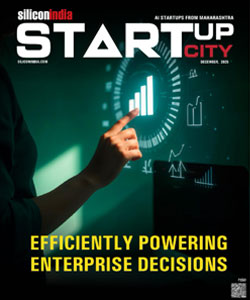Advanced Tech Reshaping India's IT Landscape

The organizations have opted to work remotely all over again, all thanks to the advanced technology that has aided the firms to operate efficiently even from one’s comfort zone. However, post-pandemic the organizations are likely to shift to the cloud. On this account, it is to be noted that the cloud market has escalated. NASSCOM reports hints that the Indian cloud computing market is currently estimated at $2.2 billion and is predicted to grow at 30 percent (year-on-year) to touch $7.1 billion by 2022.
To get a clear idea of the upgraded technological facilities and its further enhancement, I got in conversation with Sushil Goyal, Co-founder & MD at Rahi. He walked us through the importance of improved customer experience, Hyperscale data centres and cloud-based data centres.
Share your thoughts on how the pandemic has transformed the office culture amongst businesses in India
The pandemic has completely changed how and where we work, compelling companies to rethink and adopt more flexible ways of continuing business operations. . Traditionally we have been accustomed to the 9-5 hustle in a physically located office. This trend has changed as companies are shifting to remote ways of working. From an employee’s perspective, the new working model provides them flexibility in terms of location and working conditions. On the other hand, companies have an advantage of reduced costs (rent, office furniture, power), greater talent availability and enhanced productivity.
Virtual collaboration tools such as Zoom, Microsoft Teams, and others which were not considered mandatory for everyday work, except for marketing, sales and few select functions, have now become part of the daily routine. Even now as more people are getting vaccinated and businesses are making plans of bringing employees back to work, they are opting for a hybrid model. Employers overwhelmingly agree that remote work has been successful, but few are willing to abandon the office entirely. In a recent PwC survey, 68 percent of employers said that employees should come to the office three or more days per week to maintain the company’s culture. Additionally, employers believe that the office environment helps to increase productivity, provides a place to meet with clients and enables staff to collaborate more effectively. However, few employers still want a return to the pre-pandemic workplace. The majority (87 percent) of executives are reassessing their real estate strategies with an eye towards a hybrid work environment. Organizations are looking to reduce the number of assigned work areas, simultaneously social distancing and creating more space for teamwork and collaboration.
Gartner says that IT leaders need to shift their focus from infrastructure – on-premises, in the cloud or at the edge of the network – to workloads. What does this essentially mean for IT organizations?
In a post-pandemic world, it is ideal to move workloads to the cloud for benefits and to prepare for the next unforeseen disruption. When the emphasis shifts from infrastructure to workloads, decision-making focuses on service delivery rather than IT architecture. While Gartner recommends that IT get out of the business of maintaining data centers, the cloud is not always the best option. Organisations should focus on performance, availability, security, compliance and other technology and business requirements to determine workload placement. In analysing these factors, organisations should consider not only what internal IT shops can provide but what is available in the marketplace. Some legacy applications can be migrated to Software-as-a-Service solutions, but others may be hosted in co-location facilities. For example, emerging distributed cloud services can prove to be a good option as they allow running applications and data from geographically dispersed sites at the network edge.
How would you enhance customer experience by managing workload placement?
It is always recommended for organizations to work with an ecosystem of cloud, co-location and other partners to create a more agile infrastructure. Partners should be selected based upon the value they deliver to the business. The Distributed Cloud concept as mentioned above addresses a fundamental need for hybrid cloud customers. In most hybrid cloud deployments, while the customer retains control for one part of the hybrid cloud infrastructure, there is no way to leverage capabilities of the public cloud service provider. Even Gartner in their research report, mentions that distributed cloud computing is the first cloud model that incorporates physical location of cloud-delivered services as part of its definition. This is significant, as historically, location has never been part of any cloud computing contracts.
How Hyperscale data centers are playing an important role in reshaping India’s IT landscape?
With increasing usage and more dependability on IT infrastructure everything is scaling and going ‘Hyper’. And with this along comes the environmental costs due to their enormous sizes. Data Centers are now trying to operate on renewable energy to optimize their resource utilization and reduce environmental impacts. The trend will continue, and we will be seeing more and more innovation in sustainable components with improved efficiency.
A Hyperscale Data Center is a huge warehouse-like structure having its own servers, routers, storage system, powerhouse, and networks. This is generally used for big data and cloud-based applications. With ever increasing demand for data, hyperscale data centers are expected to grow at an exponential rate in the next decade.
Many industries which earlier had no or very little access to the IT infrastructure are now moving towards the cloud-based system, primarily triggered by remote working requirements. Healthcare sector, supply and logistics industries, educational institutes are primarily looking for cloud-based solutions. This has given a major boost to the hyperscale data centers. These Hyperscale Data Centers offer unique ways of energy efficiency and functionality that will make them the preferred choice of facility for most companies.
Why is there a huge normalization and wide adoption of cloud-based data centers?
The trend has definitely been shifting towards cloud-based data centers because of the benefits they offer keeping in mind the remote work situation we are in today. According to Gartner, there will be a user spending of $200 Billion by the end of 2021 on data center infrastructure which is 6% higher than the 2020 levels. Innovation, efficiency, and sustainability will be the driving force behind any data center technology going forward.
Cloud based datacenters are better than physical data centers on four key parameters:
Cost: Traditional DC installation involves purchases from various networking to server hardware vendors, and further frequent upgrades. When you use cloud servers, it basically means that you are using someone else’s resources, whereby the provider ensures quality and maintenance of the system, ensuring better resource optimization.
Accessibility: In cloud-based data centers, the data is remotely stored, managed and backed on a regular basis. Quality service providers offer the option of securely transmitting data and receiving them via a public network. At any given time, files and documents stored online can be accessed from anywhere.
Security: Traditional DCs hire security staff and install various security protocols to ensure safety. You have complete control over your data to ensure that its completely secure from unauthorized access. Cloud-based hosts are prone to data leak and hacking as mostly perceived, but in actual practice, they are constantly upgraded with cybersecurity protocols to make sure that all the safety measures are in line and user data is secured. Private clouds offer enhanced security as they have an isolated network environment and better control.
Scalability: Building a data center from scratch requires huge capex and time. Cloud-based systems enable seamless customization and scalability. Businesses can buy more storage and even reduce it as per requirements.
Learning from the past, how can IT leaders plan for unpredictable situations in the future.
IT road-mapping always comes with a level of unpredictability. It is the nature of the fast-evolving, competitive era we now live in. Start-ups enter the market, customers want experiences introduced by other industries or competitors, and technology manufacturers surprise everyone with new products and features. Even the pandemic brought a great level of uncertainty and threw IT leaders off their game. Companies had to enforce work from home for leadership, marketing, finance, and IT and they were not prepared. . Overnight IT leaders had to make decisions such as which applications could be securely moved to the cloud and how many employees needed VPN access.
To stay competitive and sustain business despite the challenges, IT leaders need the ability to acquire and deploy technology when they need it. Not when their budget cycles allow, which come about every 3-5 years. The best option is to consume technology through a service-centric consumption model and pay only for what you use and when you use it. This flexible IT consumption model will be ideal for IT leaders in today’s time when business and technology needs are constantly evolving.
Businesses also need to deploy a network architecture that enables operational efficiencies and is flexible enough. Since the pandemic, the network has expanded to global offices, homes, and on-the-go mobile devices, all the while providing data-driven and personalized experiences that follow people and things wherever they go. IT staff are inundated with management tools, dashboards, and a slew of ad hoc technologies that often may not align. Therefore, they need a resilient network architecture. And lastly, IT leaders need a reliable partner who can leverage the most flexible IT consumption model and network architecture for sustaining business and reducing risk in a constantly changing and uncertain market.
Read More News :





